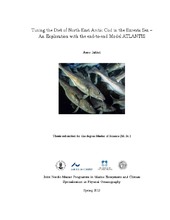| dc.description.abstract | This thesis explores the feeding relationships of Atlantic cod (Gadus morhua) on its major prey species within the Barents Sea using the newly developed Atlantis model for the region. Atlantis is an end-to-end model designed to explore the response of the ecosystem under different biological, environmental and fisheries scenarios. However, before one can develop such scenarios, the model needs to be tuned through a diet matrix that should reflect the observed diets of the major species in the system. Generating a realistic diet composition is achieved by adjusting indices linked to the strength of the predation for each prey species. The major work carried out within the thesis has been on the tuning of the cod diet. Five different model runs with different diet indices are presented and evaluated by comparing the results with the cod diet documented in the joint Russian-Norwegian (PINRO-IMR) stomach content database. Emphasis in the thesis was placed upon the prey species, capelin (Mallotus villosus) and polar cod (Boreogadus saida). A diet matrix was achieved that was able to reproduce, within an order of magnitude, the natural consumption with regards to relative amounts in terms of number of individuals and biomass of the different prey species. Higher predation pressure was found to reduce prey abundance as expected, and a negative correlation was found between cod and capelin, and also with polar cod but the relationship was much weaker than for capelin. The abundance of polar cod correlated with the amount of capelin consumed, i.e. high predation of cod on capelin results in increasing polar cod abundance. Individual weight of cod was observed to decline when there was high abundance of cod suggesting evidence of density dependent processes. Although the relative rankings of prey species consumed based on numbers of individuals and biomass generally matched the database, the absolute values did not with the model underestimating the total consumption. Suggestions for improvements in the tuning process are provided such as tuning more parameters, for example, growth and consumption rates and resolving temporal as well as geographic distributions to better determine the overlap between predators and prey. Finally, possible future research using the Atlantis model is presented. | en_US |
